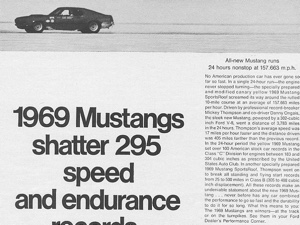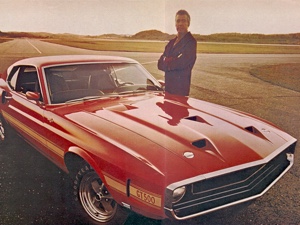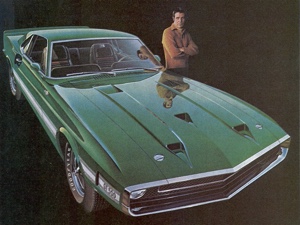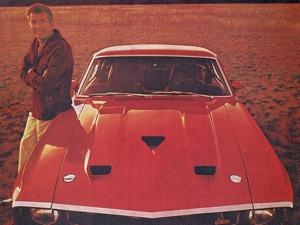1969 Mustang Information
1969 - Big Blocks, Big Sales, Big Mustangs
This was the year that Ford stepped it up. Due to increasing ambitions and more competition, Ford introduced many big block engine options for the 1969 Mustang model. This required them, yet again, to increase the overall size of their Mustangs. Many stylistic changes were made to accommodate the new look and feel of the 69 Mustang. These overhauls were widely successful, and to this day the 1969 and 1970 Mustang models are considered to be one of the best examples of what a muscle car was intended to be.
CHANGES FROM THE PREVIOUS YEARS
What were some of the stylistic changes that were made for the 69 model year? As usual, the sides were changed. The side scallops were eliminated with the exception of the Mustang fastbacks which had a unique side scoop high up on the rear fender. The front and rear of the vehicle saw some changes as well. The front grille now had an off center emblem with striping behind the pony. An extra pair of headlamps adorned the outer area of the grille and the 69 Mustangs had a new reverse exhaust side trim. Keep in mind that until the 1969 Mustang model came about, the side trim was purely cosmetic, even on the 67 Mustang model. A customer now had the rare option of upgrading to include functional side scoops for racing. A galloping horse badge replaced the area where the roof vents used to be. The wheelbase remained the same as the previous year, but the 69 Mustangs were increased by 4 inches in length and almost half an inch in girth. The Mustang coupes and convertibles were restyled with a more rectangular tail light panel.
Special Edition 1969 Mustangs
1969 MUSTANG GT
The Mustang GT was available in 1969 but the introduction of the Mach 1, Boss and Grande options lowered GT sales. 1969 was the last year that Ford sold the Mustang GT until it was reintroduced in the mid 80’s.
Many of the GT options were similar to the previous years. The 69 GT Mustang included a nonfunctional air scoop, slotted steel wheels, which were also available on other models, and simple side stripes.
1969 MUSTANG MACH I
1969 was the year that Ford debuted the Mach I. It was named after a show car Ford displayed in 1966. The Mustang Mach I was similar to a GT fastback but had different stripes and came with a more upscale interior.
Some of the features included were a blacked-out hood treatment, reflective body side tape stripes, chrome rocker panels molding, hood pins, a front spoiler attached to the front roll pan, a nonfunctional hood scoop with turn signal indicators on the back side, an engine designation badge on the side and accent stripes around the upper portion of the rear body panel. The Mach 1 also came with high-back bucket seats. A spoiler and window louvers were an available option, though they did not come standard.
The new Mach I Mustang included the previous engine options of 200cid I-6, 302cid and 390cid V-8 engines as well as the new option of a 351cid V-8. There was also the option of a 428cid big block as a 335 hp cobra jet V-8 with or without ram-air. The name Cobra Jet came from the fact that the vehicle shook when the engine started or was revved.
A few upgrades were added to complement the new engine options. These included an optional shaker hood scoop, in place of the nonfunctioning scoop, and a vacuum-operated door that opened when the throttle was floored to allow air into the carburetor. It was standard on the 428 Cobra Jet Ram-Air V-8 and optional for Mach I Mustang or GT Mustang with a 351, 390, or Boss 302 engine.
1969 MUSTANG GRANDE'
The 1969 Ford Mustang Grande’ was appropriately named, as it was all about grandeur. The Mustang Grande’ came only in hardtop and it offered 45 options. These options were geared towards the upscale market and included interior upgrades such as; "Comfortweave" hopsack upholstery, faux woodgrain dashboard, padded interior side panels, extra-thick carpet on the floorboards, two-tone narrow stripes, racing-style mirrors, chrome rocker panel moldings and wire-style wheel covers.
It came standard with a Rim Blow steering wheel, which allowed the driver to sound the horn by squeezing the wheel.
Little was different on the exterior, with the exception of a small “Grande’” emblem on the rear roof pillar.
A performance engine could be ordered for it, but it wasn’t anywhere near the range of a Mach I or Boss engine.
1969 MUSTANG BOSS 302
The Boss 302 was not in the standard sales brochure, and only 1,628 were built. The Boss 302 model was intended to convert a revised 302 engine into an eligible Trans-Am racing series vehicle.
They came in a fastback body style without side scoops, and featured a blacked-out hood, trunk lid and taillight panel. Special C-stripes were standard as well as a chin-spoiler. A rear spoiler and rear window louvers could also be added on.
1969 MUSTANG BOSS 429
The Boss 429, quite literally, is the boss! The Boss 429 is the largest engine that Ford ever offered, and it was available in the 1969 and 1970 Ford Mustang models. They were attempting to qualify for Nascar and Nascar’s rules required that at least 500 of these cars be manufactured and sold to the general public. Ford now had the task of creating a street car, that could compete in Nascar. The Boss 429 was an answer to the challenge! The Mustang Boss 429 contained a 429cid hemi-head V-8 engine. The engine was so big that the suspension had to be modified and the battery was moved to the trunk. It was advertised at 375 hp, but if it was carefully customized it was capable of exceeding 500 hp.
Ford drew attention to the Boss 429 model by including the biggest hood scoop placed on a production Mustang, complemented by a front spoiler that was similar to the Mach 1. It also came with magnesium valve covers.
1969 Mustang Shelbys
The Ford Mustang was restyled for the third time in 1969. The Mustang Shelby model greatly changed from the previous years. The sides now had two scoops, one near each wheel. The wheels were specially designed five spoke cast aluminum with steel rims. The front end was extended with a chrome steel bumper and the rear had a fiberglass spoiler. The fenders were also fiberglass. This was the first and last time that fiberglass was used on the Shelby Mustang. It also featured a fiberglass hood, hood scoops and quick release hood fasteners. 789 Shelby Mustangs remained in Ford's inventory after the 69 model year. These were modified to include a front air dam and blackout point treatment. They were then labeled and sold as 1970 Mustang models.
GT350
The 1969 Mustang Shelby GT350 was outfitted with the 351cid rather than the previous 302cid and used the Mach I body, though the badging was replaced with GT350 badging.
GT500
The GT500 continued to house the 428 Cobra Jet engine and output 335hp. Cobra, GT500 and Cobra Jet 428 emblems adorned the Mach I body platform.
1969 Mustang Ads




